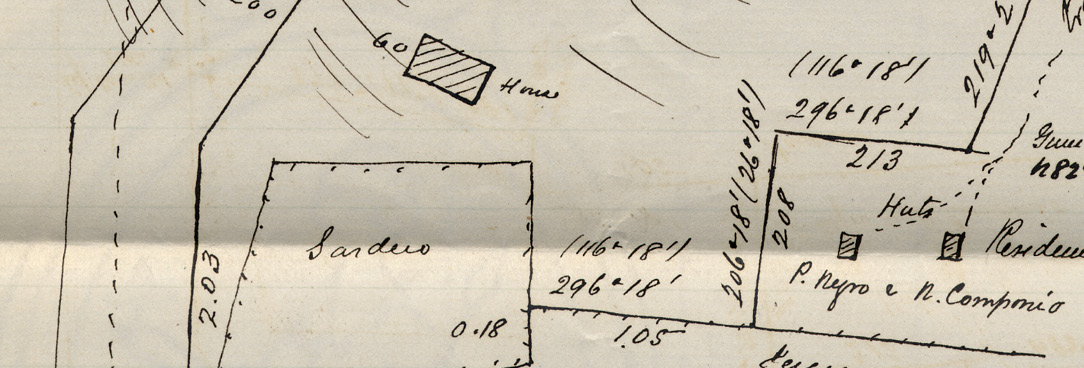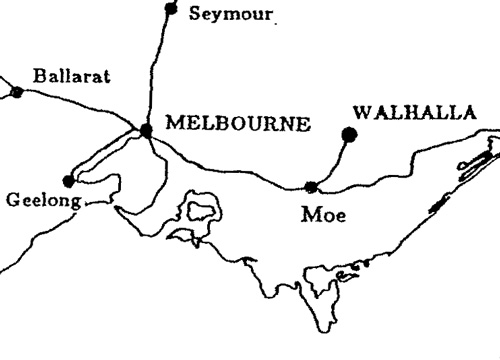Last updated:
‘Italian Speakers on the Walhalla Goldfield: A Micro-History Approach’, Provenance: The Journal of Public Record Office Victoria, issue no. 7, 2008. ISSN 1832-2522. Copyright © Annamaria Davine.
This is a peer reviewed article.
Following the discovery of gold around Walhalla in 1863, thousands of men and women flocked to the district hoping to make their fortune. Among them were hundreds of Italians and Swiss-Italians. The men worked mostly in the timber industry servicing the needs of local gold mines, but others took up different occupations. Micro-histories of small groups and the individuals within them help to challenge accepted theories. In Southern Europeans in Australia, Charles Price has argued that migrant settlements often occurred in certain areas because ‘pioneer’ or early arrivals from particular nationalities, regions or locations became involved in the same type of work, which, in turn, led to the ‘accidental’ development of migrant communities. In this article, I argue that application of Price’s model to Walhalla’s Italians makes the settlement appear one-dimensional and rigid in its composition when it was, in fact, a dynamic and interactive environment. Although offering an excellent starting point, his theory remains incomplete and does not allow for the individuality of the men and women involved, nor for the flexibility and versatility they demonstrated in their quest for prosperity. Drawing on a vast array of primary source material, including goldmining, Crown Lands and probate files, I use Vittorio Campagnolo as a case study to present an alternative scenario.
The Walhalla goldfield is located south of the Great Dividing Range, one hundred and eighty kilometres east of Melbourne, in a narrow valley surrounded by steep, densely timbered mountains and gullies. It is a remote but beautiful place.
In 1863, following the discovery of gold around Stringers Creek, thousands of men and women flocked to the district hoping to make their fortune. They were a diverse group of individuals and national and ethnic groups dominated in numbers by Anglo-Celts. Among them were hundreds of Italians and Swiss-Italians (Italians), mostly woodcutters, timber contractors, tramway builders and charcoal makers who generally worked in groups (work clusters).[1] They were also miners, owners of wine bars, hotels and boarding houses, a bootmaker and a mining agent. A number of Italians took up land on the goldfield’s periphery and became farmers. By the early 1920s, however, apart from a few remaining families and single men, most Italian speakers had left few traces of their presence in the district, and there are a variety of reasons for this. Principally, many had been sojourners, temporary workers intending to stay only for a short period before returning home.[2]
There are large gaps in the historiography of Italo-Australian society. Gentilli, O’Connor, Pascoe and Douglass have documented well the migration of specific regional or provincial groups.[3] Templeton, using letters, was able to capture the aspirations of her subjects and their motives for migrating.[4] However, apart from Carlson’s dissertation on Daylesford’s Italian-speaking settlers, there is little coherent historical understanding of the particularities of early Italian rural settlements in colonial Victoria.[5]
Essentially, the migration patterns of Italians to Australia usually involved the arrival of male migrants who moved around the country looking for work. As they became settled, they were followed by male kin, compatriots and, later, wives and children. Charles Price has argued, in part, for the ‘accidental’ development of migrant communities, with settlements springing up as ‘pioneer’ or early arrivals from particular nationalities, regions or localities became involved in the same type of work.[6] His theory has limitations (as he himself acknowledged) as it relies principally on statistical data and naturalisation applications that can provide only an impersonal and abstract description of migrants and what they may have made of their lives. Women, of course, play little part in it.
Castles and Miller refer to migrant settlements as ‘micro-structures’, informal networks developed by new arrivals in order to cope with migration and settlement. Double-sided bonds and dynamic cultural responses developed between them and the receiving population in relationships of co-operation, competitiveness and conflict.[7]
Micro-histories of small groups and the individuals within them help to challenge accepted theories. I argue here that application of Price’s model to the Italian community which developed on the Walhalla goldfield gives just a broad brush effect and discounts the flexibility and versatility of the men and women involved. While their choice of occupation may have been limited because of language, cultural and other difficulties, this did not prevent ambitious Italians from becoming involved in a wide range of work. In my Walhalla study, I found that Italians were engaged in diverse occupations, albeit mostly running parallel to the needs of a goldmining society.
In my reconstruction of the settlement, I examined large volumes of primary source material including births, deaths and marriages indexes, shipping lists, Italian records, local newspapers, and Public Record Office Victoria goldmining, Crown Lands Department and probate files. Limited information was provided by some descendants. Collectively, these helped to flesh out and develop the lives of certain Italian individuals and their families.
Individuals will always find a means to defy categorisation and Vittorio Campagnolo is a case in point. He was not restricted to any one occupation in Walhalla, but over his lifetime criss-crossed occupational boundaries whenever a fresh opportunity offered a better life for him and his family. I now trace Campagnolo’s documented life in Victoria and the various levels of his economic and social involvement around Walhalla from the 1870s until his death.
Vittorio Campagnolo was born in Bergamo in the Lombardy region in about 1849. He arrived in the colony of Victoria on the Somersetshire in December 1871, aged 22.[8] In the early years, he regularly changed occupations and places of abode in and around the various Victorian goldfields. This was typical of Italians (and others) at the time. In 1872 he spent six months in Maldon, an established goldmining centre which had a large Italian-speaking presence, probably in work associated with a mine. He went to the Walhalla goldfield for the first time after this and stayed for eighteen months.[9] Little is known of his activities except that he is referred to in a colleague’s work diary as a wood contractor.[10] After leaving Walhalla, Campagnolo went to Stawell for three years.[11] This, too, was a well-known mining destination for early Italians attracted by work and family clusters already in place. His life to this point fits within the Price model but will not continue to do so.
Vittorio Campagnolo returned to Walhalla in mid to late 1876 and, by May 1877, was working with Pietro Negri, trading in partnership as charcoal suppliers under the name ‘Negri & Campagnolo’.[12]
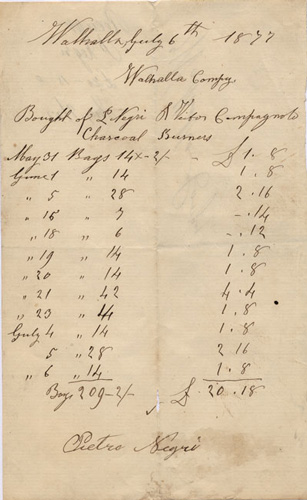
The business was part of a continuing charcoal supply line by Italians to the Walhalla Gold Mining Co. that had existed since the mine’s inception in 1865. An 1878 Crown Lands sketch outlining Campagnolo and Negri’s place of work survives. It is a rough plan of a miner’s right held by the two men in the Maidentown (also known as Pearson) area, approximately one kilometre south-east of Walhalla, where both men lived and probably operated their charcoal kilns. The residence sites on the plan, which are really just huts, are on a much smaller scale than the buildings (home and barn) on the land occupied by Rutter, their neighbour. There is also a reference to ‘track into forest for timber’ for access into the bush.[13] Whether there were other Italians living with Campagnolo or Negri, or in the vicinity, is not known, but the site is typical of many similar Italian work clusters scattered around Walhalla. These were located close to work and consisted of canvas tents or rough timber huts that could be easily dismantled, or just abandoned.
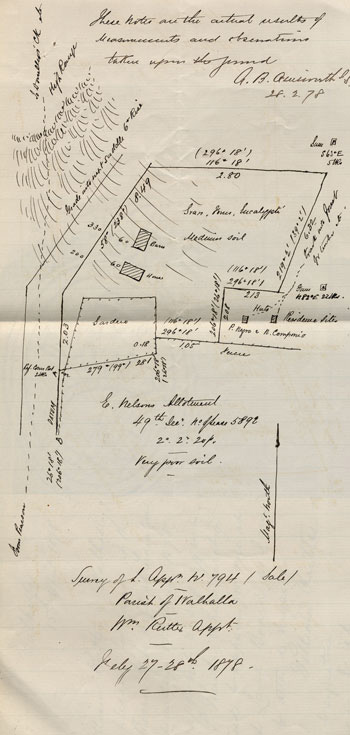
The partnership lasted until January 1880 when Campagnolo commenced trading on his own as ‘Campagnolo & Co.’ He operated on a reduced scale until the Walhalla Gold Mining Co.’s interests were sold twelve months later. After the mine’s demise, Campagnolo continued operating as a charcoal supplier and, in 1884, Middleton & Maning listed him as a ‘charcoal burner’, reflecting his ongoing commitment to char production for other local mines whose records have not survived.[14]
In a very small way, Vittorio Campagnolo was an active share trader in Walhalla’s gold mines. He put specific and calculated strategies into place with the intention of creating wealth, which involved risk-taking and speculation. For example, during his first visit to Walhalla, between June 1872 and December 1874, he purchased two Walhalla Gold Mining Co. shares with a face value of £10 each but with a market value of between £162 and £185 each.[15] After he returned to Walhalla in about June 1876, he purchased a further two shares at an unknown cost. The four shares were on-sold in January 1877.[16] Their sale coincides with the Campagnolo & Negri partnership being set up and the likely need to free up some capital for the enterprise.
Campagnolo continued trading in Walhalla Gold Mining Co. shares and, between July 1876 and August 1877, held a further ten shares with a face value of £3.[17] These may have been in lieu of cash, as it was not uncommon for suppliers and contractors to accept payment from mines in this way. However, he had little joy from the latter acquisitions and was still the unfortunate owner when he paid up a seventeenth and last call, in December 1880.[18] In 1883, mining records show that Campagnolo had a one-twenty-fourth share in the newly formed General Gordon Gold Mining Co. that fronted Stringers Creek, three and a half kilometres north of the Walhalla township. In 1888 he also held a few hundred shares in Broham’s Reef Gold Mining Co.[19] Neither mine had good yields. There may have been other share interests, records of which are now lost.
Marriage to a non-Italian woman dramatically changed the direction of most Italians and they rarely returned permanently to their home communities. In 1888, Alexander Sutherland described Vittorio Campagnolo’s position in Walhalla and noted that ‘in 1880 he married Miss Gray and has a family of four children’.[20]
A closer examination of this account reveals small inaccuracies in relation to Miss Gray’s true status. Although referred to as ‘single’ prior to her marriage, she was not in fact a ‘miss’ when she married Vittorio Campagnolo. Born on 30 June 1859, Anne (later referred to as ‘Anna’)[21] was the child of Irish emigrants, James and Mary Gray (née Mulligan), who had arrived in Victoria on the Tudor, also in June of that year.[22] Records of James and Mary’s deaths have not been found but, when Anne was sixteen, her guardians induced her to marry David Andrew Baldy with whom she had three children, Alice, David and James.[23] According to family sources, David Baldy was a waster and the couple separated after a few years of marriage. No record has been found of Vittorio and Anne’s wedding. He declined to have Anne’s children and they were cared for and brought up by the Baldy family.[24]
After his ‘marriage’, Vittorio Campagnolo moved away from charcoal production and timber cutting to become a hotelkeeper. In September 1884 he purchased the Alpine Hotel from Antonio Simonin, another Italian, and retained its name and licence.[25] Over the next few years, Vittorio and Anna renovated and extended the hotel to the extent that it became a local landmark. In 1886, when Vittorio applied for a victualler’s licence, the hotel had ‘eleven rooms exclusive of those required for family and servants’ and, by 1888, it contained fourteen rooms, with six stalled stables attached to it.[26]
It was not uncommon in colonial Victoria for hotels and wine bars to be owned and operated by Italians, particularly if they had non-Italian wives.[27] Anna Campagnolo’s ability to speak English helped Vittorio to arrange financial affairs and facilitated his engagement with the wider public. In their case, both husband and wife had complementary family backgrounds in the wine or hotel business. Prior to emigration Vittorio had been a ‘vine grower’, while Anna’s family records show that, when she was a child, her parents had been hotelkeepers on the Murray River.[28] When the family first emigrated, Anna’s father worked as a punt operator on the Murray River at Swan Hill.[29] In 1860 he took over the Lower Murray Inn after the previous licensee had become insolvent, and renamed the hostelry ‘The Punt Hotel’. It was sold in 1865.
Details of Anna Campagnolo’s early life in Walhalla are, at best, sketchy but, given her early family background, it is likely she had a hands-on role in running the hotel. It is not unreasonable to assume that Vittorio may have been only nominally in charge of the Alpine Hotel in its day-to-day operations and that Anna dealt with the staff and clientele. During his time as licensee, Campagnolo also had his General Gordon Gold Mining Co. interest to take him away from the hotel’s daily chores. Records also show that Vittorio operated a timber tramway known as ‘Campagnolos’ around this time.[30]
As hotelkeepers, Vittorio and Anna Campagnolo provided a focal point and a watering hole for Italians where they could meet and socialise, and helped draw together the scattered clusters and groups. In this way, Vittorio was a consolidator within the Italian settlement and a major player in its evolution into a cohesive and vibrant migrant community. After 1880 there are references to a few wine shops and to sly-grog shops run by Italians around Walhalla but, apart from the Alpine Hotel, no others specifically provided a decent temporary shelter for fellow countrymen.[31] While it is unlikely that many first-time Italian arrivals would have stayed in a hotel, not all were necessarily too poor to do so. Men coming into town on weekends after several weeks in the bush looked forward to a little of ‘home’ and the Campagnolos provided welcoming and familiar surroundings, a meal, a beer or spirits, and a bed. The hotel was also a refuge for Italian speakers when they were sick: Stefano Balsarino died there in 1885 after a bout of pneumonia.[32]
The Alpine Hotel was well promoted and became a popular venue for locals as well as visitors from outside districts. Vittorio and Anna arranged to have gold displays within the hotel building as an attraction to customers and to promote the local mining industry. Details are vague, but in May 1887 the Walhalla Chronicle reported that
We have seen some very rich quartz specimens in Mr. Campagnolo’s possession (licensee Alpine Hotel). They were found at upper Moondarra by a party of Italians on a prospecting tour. They have formed themselves into a company and applied for a thirty acres lease.[33]
Again, on 8 May 1891 the newspaper observed that ‘rich stone could be observed at Campagnolo’s Hotel from South Long Tunnel Gold Mine’, found in the vicinity of ‘Campagnolo’s tramway’.
Vittorio Campagnolo moved between Italian and Anglo-Celtic business and social circles with apparent ease. In 1885, at the launch of Loan’s new brewery in Walhalla, he was on its promotional Ball and Supper Committee of Management, although there is no record of him having had a commercial interest in the brewery itself.[34] He was interested in local politics and, in 1889, along with a number of prominent citizens, signed a petition supporting the election of Charles Amor as the Shire auditor.[35] He was also on the Walhalla Common Jurors’ List of 1883-84 and 1891-92.[36]
Campagnolo was a regular donor to charitable appeals, in particular those relating to mining accidents.[37] He also supported local musical events. For example, he was a subscriber to the local Mountaineers’ Brass Band and made regular donations to it.[38]
While many of Vittorio Campagnolo’s business and social activities took him away from his compatriots and cluster life, strong ties remained that enabled him to become an intermediary between Italian and local interests. On occasion, he acted as court interpreter in legal proceedings. The court cases were varied and sometimes related to quarrels between Italians over money or charges of assault. For example, in January 1887 he interpreted during a wages dispute between two Italians.[39] Later that year, in July, he assisted in a serious assault case following a dispute over timber supplies.[40] Vittorio also defended his own interests and actively pursued debts owing to the Alpine Hotel through the courts.[41]
However, fortune did not always shine on Campagnolo. In August 1891, disaster struck the family. A torrential downpour, followed by massive local floods, swept through Walhalla township. The Walhalla Chronicle reported that Campagnolo’s Alpine Hotel was
frightfully wrecked, not only sustaining irreparable damage from the water but the windows and doors were smashed in by huge stones and boulders of rock which were brought down with terrific force by the storm water from the gully at the back of the hotel and filled the rooms.
Locally, damage was widespread, particularly to the firewood tramlines, roads and tracks, and the district became isolated by damaging landslides. The Campagnolo family was forced to move to a house they owned just forty yards opposite the hotel.[42]
The situation continued to deteriorate. One week later, the hotel’s shell was burned to the ground and its charred remains were all that was left of ‘one of the strongest weatherboard buildings and oldest landmarks in Walhalla’. The hotel stables were saved and it was noted that ‘Mr. Campagnolo must be one of the heaviest individual losers in a pecuniary sense’. The building was insured for £600 ($55,000) and for £300 ($27,500) in stock.[43] Considering it had been valued at £1500 ($132,000) in 1888, Vittorio had grossly underinsured the Alpine Hotel and its stock, and he was to suffer the consequences. 1891 was a bad year. His interest in General Gordon Gold Mining Co. had reaped little or no profit, and in April its plant was sold to another mine.[44]
Vittorio Campagnolo’s hotel-keeping days were over but he quickly moved on and became involved in farming, perhaps fulfilling a pre-migration aspiration to own land. This was not an unusual feature for Italians in the study, as many had emigrated, not only for basic economic reasons, but also to advance their family status through the acquisition of land back home. Campagnolo never returned to his home community but he may have applied this landowning desire in an Australian and local context.
The land that Campagnolo leased in 1892, and later purchased, from the Crown Lands Department had been previously, but unsuccessfully, taken up by two of his compatriots.[45]
His Land Selection File shows that, in March that year, he took over a Crown Land lease from Giovanni Valli, an Italian, of approximately 64.40 hectares (159 acres) at Ostlers Creek, a small farming settlement approximately sixteen kilometres (ten miles) south of Walhalla, on the Walhalla-Toongabbie Road.[46]
The terrain was very steep and only some of the land was suitable for cultivation. When Vittorio took possession of the farm, it was not fully fenced, only partly cleared, and improvements included an area of ringed timber and cut and burnt scrub. Cultivation, totalling 8.05 hectares (twenty acres), included crops of oats, peas and potatoes. The previous owners had planted an orchard of 100 fruit trees together with a vineyard and vines, continuing a home tradition of wine-making. The dwelling was of log, slab and bark construction and outbuildings included a stable, cowshed, pigsties and sheds.
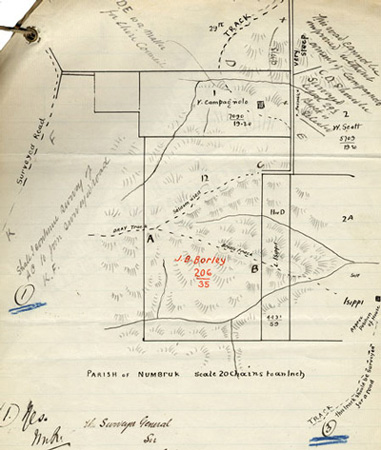
Between 1892 and early 1894, Vittorio and Anna Campagnolo settled their family at Ostlers Creek but, for reasons that are not entirely clear, returned to live closer to the Walhalla township in 1894. The farm’s previous history suggests that it was not overly productive, but the land was not abandoned and, when the family left, an employee was engaged to work and reside on the property.
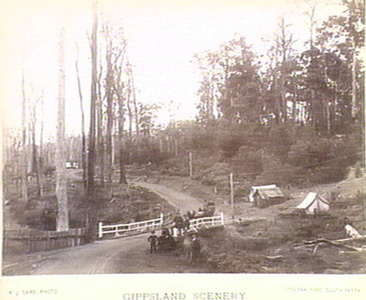
After his seemingly short attempt at farming, Vittorio Campagnolo resumed work as a timber contractor. It is possible that he had not ceased his involvement in woodcutting and associated industries during his time at Ostlers Creek, but there are no extant records on that account. In February 1894, and further expanding his interests, he was a co-applicant for a tramway licence of four acres located at Marsdens Creek to the east of the Old Walhalla Road. The land was to be used as a narrow-gauge timber tramway with an estimated building cost of £600 ($65,400).[47] The tramway was 1.6 kilometres in length, was horse-driven and hand-operated, and was commonly known as ‘Campagnolo’s firewood tramway’. It may have been an extension of the one in operation in 1891.[48] During the next five years or so, Campagnolo operated the tramway to transport and supply cut timber to the Long Tunnel Gold Mining Co.[49] Records show that Vittorio employed both Italian and non-Italian men. The size of his overall operations and number of employees are not known, but Long Tunnel Gold Mine was not the only mine Vittorio supplied: in 1895 he was referred to in the Walhalla Chronicle as ‘a firewood contractor for several of the mines’.[50]
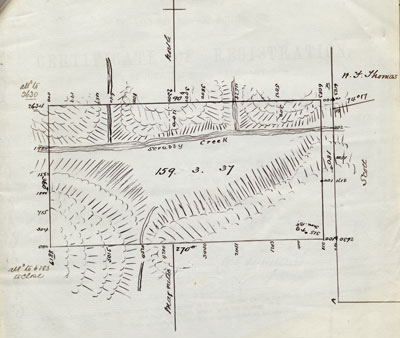
Bad luck continued to follow Campagnolo. In September 1895 he suffered a compound fracture of the right leg. He was starting the flywheel of the steam-operated engine, used for hauling wood up the tramway to the top of the hill, when he placed his foot on the wheel and was injured.[51] The bone in his leg was shattered and he was conveyed, with great difficulty, to his home along a rugged downhill track. The leg was saved, but in June 1897, nearly two years later, he suffered a further break to the same leg. On this occasion he had gone into Walhalla to have a horse shod. While at the blacksmith he had climbed onto a bench to mount his horse, but the horse swerved and he fell to the ground. The leg was later amputated.[52]
In 1900, perhaps due to failing health, Vittorio Campagnolo and his family again returned to live at Ostlers Creek. The Crown Lands Department file shows that, in the summer of 1897-98, a bushfire had burnt through the property and destroyed everything in its path.[53] The house, outbuildings and fences were totally rebuilt and, in 1901, Vittorio made an application to transfer his lease of the land into a Crown Grant. While the land was not totally enclosed, it had 120 chains (2415m) of post-and-rail fencing and 70 chains (1408m) of post, rail and slab fencing.[54] There were now thirty acres under cultivation with a fruit garden enclosed by a picket fence of eight chains. Erected on the land was a five-roomed dwelling house constructed of hardwood outside and pine lining inside; the five rooms were all twelve feet square. The house had a zinc roof and stone chimneys. There was also a stable built of slabs with a bark roof. The purchase price was £160 ($15,500), being the total rental paid for the lease over its term. The value of improvements to the farm totalled £693 ($67,500). Vittorio had difficulty in paying the outstanding rental and the costs of transfer. He was forced to write to the Crown Lands Department for leniency, acknowledging that ‘I am behind with my rent’ and ‘I lost one of my legs three years ago. I am living on the land with my wife and ten children, [but the] land is not mortgaged’.[55]
After re-settling at Ostlers Creek, Vittorio’s local profile was reduced. He no longer appeared to be operating his tramway or supplying cut timber to local mines. There are no known reports of him acting as a facilitator or interpreter, or of any engagement in local business or social affairs. He died on 5 January 1903 of heart failure, aged 53 years, at ‘his residence at Ostlers Creek, beloved husband of Anna Campagnolo’.[56] He was never naturalised and died intestate. The absence of a Will disadvantaged Anna financially as her husband’s intestacy meant that she was only legally entitled to one-third of Vittorio’s estate, and his infant children were to receive the remainder on attaining adulthood.[57] Vittorio and Anna had the following children: Victor (b. 1881), Grace (b. 1883), Teodoro (b. 1884), Victorina (b. 1887), Rudolf (b. and d. 1888), Hilda (b. 1889), Leopold (b. 1891), Teresa (b. 1893), Eugenie (b. 1895), Ernesto (b. 1897), Adelina (b. 1899) and Ada (b. 1903, after her father’s death). Of the twelve children, ten were living and nine were still minors living at home when Vittorio died.
In June 1903, Anna Campagnolo applied for a grant of Letters of Administration, and the relevant file provides a glimpse into her life and her financial struggle to carry on the family farm after her husband’s death.[58] It also reveals the little-recorded part played by women married to Italian speakers when they were widowed or forced to take over the mantle as head of the family. The Inventory and Statement of Assets and Liabilities of the estate signed by Anna show the farm was valued, for death duty purposes, at just over £458 ($42,200). While this was less than the purchase price paid in 1901, it would have been a conservative figure applied so as to attract less probate duty. Improvements on the land included a stable, barn, pigsty, fowl house and orchard. Two acres of potatoes were planted, one acre of oats and half an acre of maize. Animals included an ageing horse, ten cattle and five pigs valued at £30 ($2,920). Usual farm tools included two ploughs, one harrow, one waggonette, a blacksmith’s anvil, bellows, hammers, two spades and three hoes. Other items were two horse collars, one pack-saddle and one riding saddle. The bank overdraft was just over £10 ($975). Probate duty on the estate was assessed at £2 16s. 10p. (c. $250).
Under the conditions of a grant of Letters of Administration, Anna Campagnolo was required to lodge with the Court a yearly account of the estate’s management, and her regular reports provide a picture of her capability to run the farm and to harness, as best she could, its resources. She was physically active on the property, maintaining a hands-on approach that reflected her role in the operation of the Alpine Hotel with Vittorio in the preceding decades. In September 1903 she advised the Court that the potatoes, maize and oats referred to in her previous affidavit had been consumed by her family and by stock. She had sold three cattle for £14 12s. and one pig for £2; another pig had died. Money received from the sale of the stock had been used to pay family debts. Despite difficulties, Anna was enterprising and hard-working. In the time since her husband’s death she had planted forty young fruit trees and cleared, ploughed and fenced a further three acres.[59]
Anna’s 1904 summary shows, however, that the family’s assets continued to decline. During the previous year, she had sold one steer and two aged cows for nearly £11. With the funds raised she paid £3 off her overdraft, paid her rates and used the balance for food and clothes. Livestock numbers were dwindling, now reduced to nine cattle, two pigs and one aged horse but, again, she had continued to clear the land and had fenced two paddocks of about three acres.
Despite her efforts, Anna Campagnolo finally lost her battle to keep the farm. In December 1906, Ellen Maria and Charles Collins, friends and local business proprietors who had given surety over Vittorio’s estate, advised the Court that they had no objection to Anna Campagnolo selling the farm at Ostlers Creek as ‘we are sure she has done the right thing as it is impossible for her to make a living on the land in question’.[60]
It is not known what amount Anna received from the sale of the farm. In 1907 she purchased a house in nearby Toongabbie about which there is little information as all records were destroyed in the Shire of Narracan municipal office fire in the 1960s.[61] In 1923, Anna Campagnolo died of pneumonia at Toongabbie, aged 63. She left an estate of £275 ($14,145).[62]
Vittorio Campagnolo only partly fits into Price’s model of immigrant communities. He is an example of an individual who was initially part of the local timber industry and work cluster system, and who enjoyed the economic benefits and camaraderie that flowed from them. But, as his ambitions grew, he moved outside the boundaries of cluster life and worked in other occupations that better fulfilled his aspirations. Even though he married a non-Italian woman, Campagnolo remained aligned to the work cluster system and utilised its human resources to further his business interests. In doing so, he perpetuated the on-flowing opportunities provided and sustained by work clusters which he himself had benefited from after his arrival in Walhalla in the 1870s.
Price’s model provides a useful tool for the historian to develop a theme or concept. By drawing on the small and seemingly insignificant, the Walhalla Italians study has helped to develop broader themes of migration which test a formularised and impersonal approach. Micro-histories focus on the finer detail of a small place and on ordinary lives and bring to life something of the past and the way men and women may have lived. Their use also emphasises the relevance of such studies within the wider national and international study of migration and its patterns.
Endnotes
[1] Most of Walhalla’s Italians came from adjoining districts on the Italian and Swiss border. The Italian nationals were from the region of Lombardy, to the north of Milan, mainly the city of Tirano in Sondrio province and its surrounding districts. The Swiss citizens were Italian-speaking ethnic Lombards from the Ticino and Grisons cantons of southern Switzerland. Historically, both groups shared a common dialect and a cultural affinity. ‘Work cluster’ serves as a useful term to describe and roughly summarise the composition of the scattered group of Italian speakers, initially almost exclusively male.
[2] This paper has been taken from my PhD thesis ‘Migration, work and community: Italian speakers in Walhalla’s goldmining district – 1865-1915’, Department of History, University of Melbourne, 2006.
[3] J Gentilli, ‘The settlement of the Swiss Ticino immigrants in Australia’, Geowest: working papers of the Department of Geography, University of Western Australia, no. 23, 1988; J Gentilli, ‘Swiss Poschiavini in Australia’, Geowest, no. 25, 1990; D O’Connor, No need to be afraid: Italian settlers in South Australia between 1839 and the Second World War, Wakefield Press, Kent Town, South Australia, 1996; R Pascoe, Buongiorno Australia, Greenhouse Publications, Melbourne, 1987; and WA Douglass, From Italy to Ingham, Queensland University Press, St Lucia, 1995. See also G Cheda, L’emigrazione ticinese in Australia, vols 1 & 2, Armando Dadò editore, Locarno, 1976.
[4] J Templeton, From the mountains to the bush: Italian migrants write home from Australia 1860-1962, edited by J Lack assisted by G Di Lorenzo, University of Western Australia Press, Crawley, 2003.
[5] BR Carlson, ‘Immigrant place-making in colonial Australia: the Italian-speaking settlers of Daylesford’, PhD thesis, Department of Social & Cultural Studies, Victoria University, Melbourne, 1997.
[6] C Price, Southern Europeans in Australia, Oxford University Press, Melbourne, 1963, in particular, pp. 166-9. See also Price, The methods & statistics of ‘Southern Europeans in Australia’, Australian National University, Canberra, 1963.
[7] S Castles & MJ Miller, The age of migration, Guildford Press, New York, 1993, p. 23.
[8] Only a few bergamaschi have been recorded in Walhalla.
[9] A Sutherland, Victoria and its metropolis, past and present, McCarron, Bird & Co., Melbourne, 1888, vol. 2, p. 369.
[10] Pietro Bombardieri, diary, J Templeton collection, Italian Historical Society, Carlton.
[11] Sutherland, vol. 2, p. 369.
[12] PROV, VPRS 604/P0, Units 6, 13 & 17, Walhalla Gold Mining Co., shareholders’ register, dividend & wages books. National Archives Australia (NAA), series A712/1, no. 1868/55908. Pietro Negri was born in 1843 in Madonna di Tirano, Sondrio province and migrated to Victoria in 1870. He had taken over the charcoal business from Pietro Raselli in early 1877. See also PROV, VPRS 1383/P0, Unit 5, Walhalla Gold Mining Co. & ‘Negri & Campagnolo’.
[13] PROV, VPRS 5357/P0, Unit 1235, File 794/49, Rutter, dated 1878. ‘Componio’ should be ‘Campagnolo’.
[14] A Middleton & FB Maning, Middleton and Maning’s Gippsland directory for 1884 and 1885, Melbourne, 1885.
[15] PROV, VPRS 604/P0, Unit 4, Walhalla Gold Mining Co. In 1874 the market value of a share was around $14,000 in today’s figures (formula applied from the Australian Bureau of Statistics Year Book, 2000, p. 724).
[16] ibid., Units 4 and 6.
[17] ibid., Units 4, 6 and 16, Walhalla Gold Mining Co. share register.
[18] PROV, VPRS 603/P0, Unit 53, Walhalla Gold Mining Co.
[19] Walhalla Chronicle, 1 June 1888.
[20] Sutherland, vol. 2, p. 369.
[21] ‘Anne’ became ‘Anna’ sometime after her marriage to Campagnolo. She was named ‘Anna’ on her tombstone and in her will.
[22] Index to Unassisted Inward Passenger Lists to Victoria 1852-1923 (British, Foreign and New Zealand Ports), PROV, online database. Further information about the family comes from Kit Campagnolo, a great-grandson, in a letter to the author dated 1 December 2002. Anna’s parents were married at Antrim, Northern Ireland. She had an older brother, John.
[23] Pioneer Index, Victoria 1836-1888: index to births, deaths and marriages in Victoria, 3rd rev. edn, 1999 (CD-ROM). Anne’s children were Alice Edith (b. Swan Hill, 1876), David (b. Swan Hill, 1877) and James Gray (1878-82).
[24] Records of David Andrew Baldy cannot be traced. David junior never forgave his mother but, in adulthood, daughter Alice was reconciled with her mother, her stepbrothers and stepsisters.
[25] Walhalla Chronicle, 12 September 1884. From my observations, the Alpine Hotel was located in Brewery Gully near the cemetery track, two blocks north of the present Walhalla Lodge. The Licensing Act 1890, Section 177, required that ‘no new licence shall be granted nor any licence transferred to any person whatever who is not a natural born or naturalized subject of Her Majesty’. Campagnolo never became naturalised but remained licensee of the Alpine Hotel until late 1891, reflecting, in his case, lax local enforcement of the Act.
[26] Sutherland, vol. 2, p. 369.
[27] See Carlson, ‘Immigrant place-making’ and C Gervasoni, Bullboar, macaroni & mineral water: spa country’s Swiss/Italian story, Hepburn Springs Swiss Italian Festa Inc., Hepburn Springs, 2005.
[28] Index to Unassisted Inward Passenger Lists, 1852-1923; information about Anna’s family kindly provided by Kit Campagnolo.
[29] A punt is a shallow, flat-bottomed boat.
[30] J Aldersea & B Hood, Walhalla: valley of gold, Walhalla Publishing, Trafalgar, 2003, p. 38.
[31] WH Lee, The Switzerland of Australia: views of early Walhalla and district, Lee brothers, Walhalla, 1910, revised and re-published for the Walhalla Chronicle, Moondarra, Toombon & Woods Point Times, 1981, p. 55. The Alpine Hotel was one of fifteen hotels in the Walhalla district.
[32] Walhalla Chronicle, 3 December 1885. Balsarino was a Swiss national.
[33] ibid., 20 May 1887. No further details about these displays have been found.
[34] ibid., 11 September 1885.
[35] ibid., 26 July 1889.
[36] PROV, VPRS 1501/P0, Unit 4 Common Jurors Book.
[37] Walhalla Chronicle, 19 January 1883 (appeal organised by Long Tunnel Extended Gold Mining Co.); ibid., 8 July 1887 (Bulli Disaster Relief Fund).
[38] ibid., 28 May 1886, 26 June 1891.
[39] ibid., 21 January 1887 (‘Batisla’ [that is, Battista]) and A Anda).
[40] ibid., 22 July 1887, 5 August 1887.
[41] ibid., 21 November 1890 & PROV, VPRS 359/P0, Unit 2, debt G Smith; Walhalla Chronicle, 18 February 1887.
[42] Walhalla Chronicle, 7 August 1891. This was probably the ‘large house on the hill, which he let’, referred to in Sutherland, vol. 2, p. 369.
[43] ibid., 14 August 1891.
[44] ibid., 10 April 1891.
[45] PROV, VPRS 626/P0, Unit 1969, licence no. 7090/20.
[46] The lease specified Campagnolo’s land as Allotment 1, Section D, Parish of Numbruk (transfer of leasehold 5 March 1892). The land had been initially selected by Francesco Melano (also known as Milano), an Italian national, in 1880 and was held by him until 1886. Milano had not continuously resided on the property and was therefore in contravention of his lease: it is recorded in his file that he ‘had hired a servant to reside on it since he selected it and visits once a month’. While he risked forfeiting his rights to the leasehold for this non-compliance, in 1886 he applied for a licence lien in favour of Giovanni Valli, for £268 and as an execution creditor for approximately the same amount. Valli was probably the ‘servant’ referred to in the file as he had resided on the property since 1881. Milano subsequently became insolvent. Prior to 1885, Giovanni Valli married Julia Sheehan (or Shay) and lived on the land at Ostlers Creek. After his move from that property he continued to live locally until Julia died at Toongabbie in 1898 (Indexes to births, deaths and marriages in Victoria).
[47] Walhalla Chronicle, 23 February 1894. The partner was Reuben J Salvado.
[48] ibid. For a description of the tramway see PROV, VPRS 1502/P0, Unit 4, ref. Victorian Government Gazette, 01/1123. The lease was declared void in 1901.
[49] PROV, VPRS 603/P0, Unit 54, Long Tunnel Gold Mining Co.
[50] Walhalla Chronicle, 6 September 1895.
[51] ibid.
[52] ibid., 4 June 1897. He was hospitalised until 22 July 1897.
[53] PROV, VPRS 626/P0, Unit 1969, licence no. 7090/20.
[54] ibid., Crown Lands Bailiff’s report, 14 March 1901.
[55] ibid., letter from Campagnolo to the Department of Crown Lands, 12 February 1901.
[56] Walhalla Chronicle, 16 January 1903.
[57] Under the predecessor of the current Section 52 of the Administration and Probate Act 1958 in force at the time of Campagnolo’s death, when a man died intestate leaving a widow and children, the widow received one-third of the estate and the remaining two-thirds was held (in the case of minors, in trust) for the children.
[58] PROV, VPRS 28/P2, Unit 647, File 87/138 and VPRS 28/P0, Unit 1119, File 87/139 (Letters of Administration).
[59] Affidavit dated 26 September 1903, in ibid.
[60] Letter from EM and C Collins to Court, 18 December 1906, in ibid.
[61] The Shire of Walhalla merged with the Shire of Narracan in c.1930.
[62] PROV, VPRS 7591/P2, Unit 669, File 187/164 and VPRS 28/P3, Unit 1293, File 187/164 (will and probate of Anna Campagnolo).
Material in the Public Record Office Victoria archival collection contains words and descriptions that reflect attitudes and government policies at different times which may be insensitive and upsetting
Aboriginal and Torres Strait Islander Peoples should be aware the collection and website may contain images, voices and names of deceased persons.
PROV provides advice to researchers wishing to access, publish or re-use records about Aboriginal Peoples
